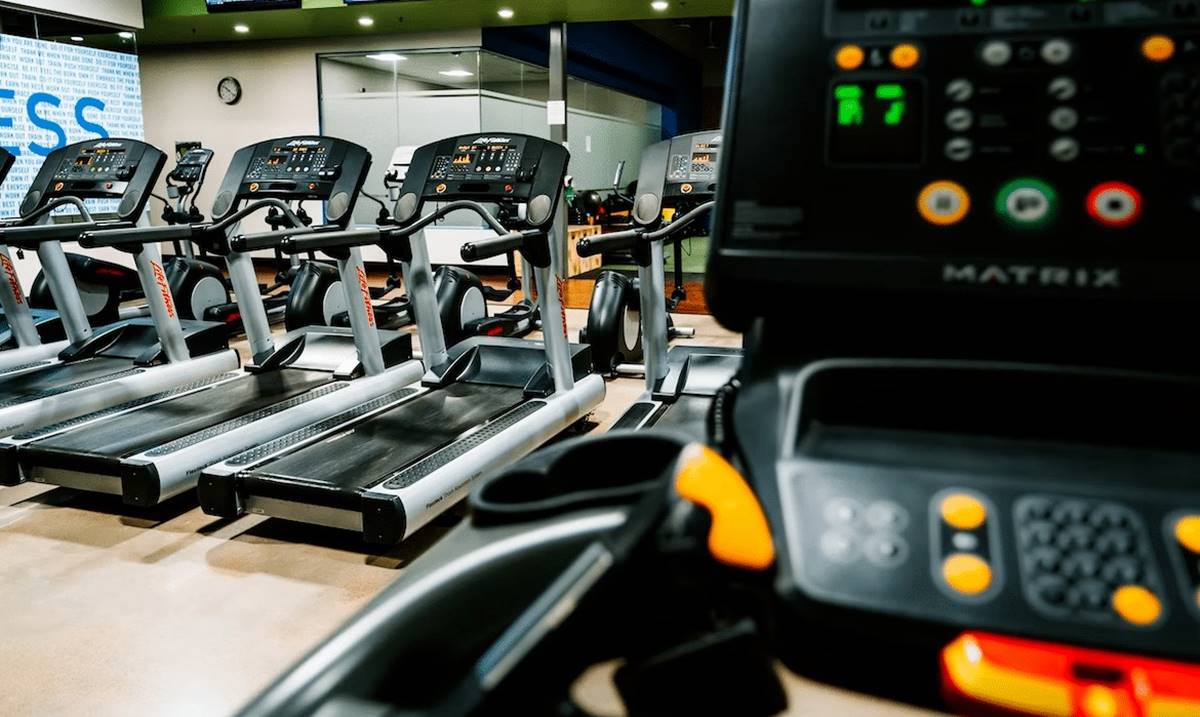

Featured
What Is Moderate Exercise
Published: September 30, 2023
Discover the benefits of moderate exercise and how it can improve your overall health and well-being. Get featured tips and insights on incorporating exercise into your daily routine.
Introduction
Welcome to the world of exercise! If you’re here, you’re probably interested in learning more about moderate exercise and what it entails. Exercise is a vital component of a healthy lifestyle, and finding the right balance is key. Moderate exercise is an excellent option for those who want to improve their fitness level without pushing themselves too hard.
So, what exactly is moderate exercise? It refers to physical activity that falls somewhere between light intensity and vigorous intensity. Moderate exercise typically increases your heart rate and breathing, but you can still carry on a conversation while performing it. It is a sustainable level of exertion that allows you to challenge your body without overexerting yourself.
The benefits of moderate exercise are numerous and can positively impact both your physical and mental well-being. Engaging in regular moderate exercise has been shown to improve cardiovascular health, enhance weight management, boost cognitive function, and reduce the risk of chronic diseases such as diabetes and certain types of cancer.
There are countless activities that fall under the umbrella of moderate exercise. Some examples include brisk walking, cycling at a moderate pace, swimming, dancing, hiking, and gardening. The key is to choose an activity that you enjoy and that suits your fitness level.
If you’re new to moderate exercise or have been out of the fitness game for a while, it’s important to start slowly and gradually build up your endurance. Incorporating short bursts of moderate exercise into your routine a few times a week is a great way to get started.
In this article, we’ll delve deeper into the benefits of moderate exercise, provide examples of activities you can try, and share tips on how to start and maintain a moderate exercise routine. So, let’s lace up our sneakers, put on our workout gear, and get ready to embrace the world of moderate exercise!
Definition of Moderate Exercise
Before we explore the benefits and examples of moderate exercise, let’s first define what it means to engage in this type of physical activity. Moderate exercise, as the name suggests, falls between light intensity exercise and vigorous intensity exercise on the exertion scale.
According to the Centers for Disease Control and Prevention (CDC), moderate exercise is defined as any physical activity that causes a noticeable increase in your heart rate and breathing, but still allows you to carry on a conversation comfortably. It’s important to note that what may be considered moderate for one person may differ for another, as it depends on factors such as age, fitness level, and overall health.
To further understand the intensity of moderate exercise, it can be measured using the Borg Rating of Perceived Exertion (RPE) scale. This scale ranges from 6 to 20, with 6 being no exertion at all and 20 being maximum exertion. Moderate exercise typically falls between 12 to 14 on the RPE scale, indicating a moderate level of effort.
When engaging in moderate exercise, you should feel your heart beating faster, your breathing rate increase slightly, and a light sweat may appear. However, you should still feel comfortable enough to hold a conversation without feeling completely out of breath.
It’s important to distinguish moderate exercise from vigorous intensity exercise. Vigorous exercise, such as running or high-intensity interval training (HIIT), requires a higher level of exertion, causing a significant increase in heart rate and heavy breathing. In contrast, moderate exercise offers a more sustainable level of exertion, making it suitable for individuals of varying fitness levels and abilities.
Engaging in regular moderate exercise provides a wide range of health benefits, making it a recommended part of a well-rounded fitness routine. In the next section, we will explore some of the advantages that moderate exercise can offer to both your physical and mental well-being.
Benefits of Moderate Exercise
Moderate exercise offers a multitude of benefits for your overall health and well-being. Whether you’re looking to improve your physical fitness, manage weight, or enhance your mental clarity, incorporating moderate exercise into your routine can have a transformative impact. Let’s take a closer look at some of the key benefits:
- Improved cardiovascular health: Engaging in moderate exercise helps strengthen your heart, improve circulation, and lower blood pressure. It can reduce the risk of heart disease, stroke, and other cardiovascular conditions.
- Weight management: Moderate exercise can aid in weight loss or weight maintenance by burning calories and boosting metabolism. It also helps build lean muscle mass, which in turn increases your overall calorie expenditure.
- Enhanced mood and mental well-being: When you exercise, your brain releases endorphins, which are natural mood boosters. Moderate exercise promotes feelings of happiness, reduces stress and anxiety, and can alleviate symptoms of depression.
- Increased energy levels: Regular moderate exercise can improve your energy levels and combat fatigue. It stimulates the production of mitochondria, the powerhouse of your cells, leading to increased energy production.
- Strengthened muscles and bones: Moderate exercise, such as weightlifting and resistance training, helps build muscle strength and increases bone density, reducing the risk of osteoporosis and fractures.
- Improved cognitive function: Engaging in moderate exercise improves blood flow to the brain, leading to enhanced cognitive function, better memory retention, and increased creativity and focus.
- Reduced risk of chronic diseases: Regular moderate exercise can lower the risk of chronic conditions such as type 2 diabetes, certain types of cancer, and metabolic syndrome.
- Better sleep quality: Moderate exercise can improve sleep patterns and promote better sleep quality, helping you feel more rested and rejuvenated.
It’s important to note that the benefits of moderate exercise are not only physical but also extend to your mental and emotional well-being. Regularly engaging in moderate exercise can boost your self-confidence, improve body image, and provide a sense of accomplishment and empowerment.
Now that we understand the numerous benefits of moderate exercise, let’s explore some examples of activities that fall under this category.
Examples of Moderate Exercise
When it comes to moderate exercise, there are plenty of activities to choose from that can get your heart pumping and provide a great workout without pushing you to your limits. Here are some examples of moderate exercises that you can incorporate into your routine:
- Brisk Walking: Walking at a brisk pace is a simple yet effective form of moderate exercise. It requires no special equipment and can be done almost anywhere. Aim to walk for at least 30 minutes a day, five days a week.
- Cycling: Whether it’s on a stationary bike or outdoors, cycling at a moderate pace is a fantastic cardiovascular workout. Be sure to adjust the resistance or gears to keep your heart rate elevated and challenge yourself.
- Swimming: Swimming is a low-impact exercise that provides a full-body workout. It’s gentle on the joints while still offering resistance, making it an ideal choice for those with joint pain or injuries.
- Dancing: Get your groove on! Dancing is not only a fun and enjoyable activity, but it also offers a great cardiovascular workout. Whether it’s salsa, hip-hop, or ballroom, dancing can improve coordination, flexibility, and balance.
- Hiking: Enjoy the great outdoors and engage in moderate exercise by going for a hike. It not only provides a physical challenge but also allows you to immerse yourself in nature and enjoy the mental benefits of being in a serene environment.
- Gardening: Believe it or not, gardening can be a form of moderate exercise. Digging, planting, and weeding can engage your muscles and get your heart rate up. Plus, you get to enjoy the beauty of your garden as it blooms!
- Yoga: While yoga is often associated with flexibility and relaxation, it can also be a form of moderate exercise. Flow-based or power yoga sessions can increase your heart rate and provide strength-building benefits.
- Group fitness classes: Joining a moderate-intensity group fitness class, such as Zumba, aerobics, or kickboxing, can provide motivation and make exercise more enjoyable. These classes typically offer a mix of cardio and strength training exercises.
Remember, the key is to choose activities that you enjoy and that align with your fitness level and interests. By finding activities that you genuinely love, you’re more likely to stick with them and make exercise a regular part of your lifestyle.
Now that we have plenty of exercise ideas, let’s explore how you can start a moderate exercise routine.
How to Start a Moderate Exercise Routine
Starting a moderate exercise routine doesn’t have to be overwhelming. With a few simple steps, you can get on the right track towards a healthier, more active lifestyle. Here are some tips to help you get started:
- Consult with your healthcare provider: Before starting any exercise program, especially if you have any underlying health conditions, it’s essential to consult with your healthcare provider. They can provide personalized guidance and ensure that you’re cleared for physical activity.
- Set realistic goals: Define your fitness goals and establish a realistic plan. Start by setting small, attainable goals to avoid feeling overwhelmed. Gradually increase the duration and intensity of your workouts as you progress.
- Choose activities you enjoy: Find physical activities that you genuinely enjoy. Whether it’s dancing, swimming, or cycling, selecting activities that you find enjoyable increases the likelihood that you’ll stick with your routine in the long run.
- Pace yourself: Start slowly and gradually increase the intensity and duration of your workouts. Pushing yourself too hard in the beginning can lead to burnout or injury. Listen to your body and give yourself time to adjust to the new routine.
- Find an exercise buddy or join a class: Exercising with a friend or joining a group fitness class can help keep you motivated and accountable. It can also make the experience more enjoyable and sociable.
- Use a fitness tracker or app: Consider using a fitness tracker or smartphone app to monitor your progress, track your activity, and set achievable goals. These tools can provide valuable insights and help you stay motivated.
- Warm up and cool down: Always start your exercise session with a proper warm-up to prepare your muscles and prevent injuries. Likewise, end your workout with a cool-down period that includes stretching to help your body recover.
- Listen to your body: Pay attention to how your body feels during and after exercise. It’s normal to experience some muscle soreness, but if you feel any sharp or persistent pain, it’s important to back off and give yourself time to recover.
- Stay consistent: Consistency is key. Make moderate exercise a regular part of your daily or weekly routine. Aim for at least 150 minutes of moderate-intensity exercise per week, spread out over several days.
Remember, the journey to better health and fitness is a marathon, not a sprint. Be patient with yourself, celebrate your progress, and don’t be too hard on yourself if you miss a workout or have a setback. The most important thing is to stay consistent and have fun with your exercise routine.
Now that you have the tools to start and maintain a moderate exercise routine, let’s explore some tips on how to stay on track.
Tips for Maintaining a Moderate Exercise Routine
Maintaining a regular exercise routine can sometimes be challenging, especially when life gets busy. However, with the right strategies and mindset, you can stay motivated and on track. Here are some tips to help you maintain your moderate exercise routine:
- Set a schedule: Plan your workouts in advance and mark them on your calendar. Treat your exercise sessions as appointments that you cannot miss. Having a set schedule increases accountability and helps you prioritize your fitness goals.
- Find a workout buddy: Exercising with a friend or family member can be more enjoyable and motivating. Find someone who shares your fitness goals and schedule regular workout sessions together.
- Make it a habit: Consistency is key to maintaining a moderate exercise routine. Make it a habit by incorporating physical activity into your daily life. Whether it’s taking the stairs instead of the elevator or walking during your lunch break, find small ways to stay active every day.
- Track your progress: Keep a journal or use a fitness app to track your workouts, record your progress, and celebrate milestones. Seeing your achievements on paper or in digital form can provide a sense of accomplishment and motivate you to keep going.
- Vary your workouts: Combat boredom and prevent plateaus by incorporating variety into your exercise routine. Try different activities, explore new fitness classes, or switch up your exercise environment to keep things fresh and exciting.
- Set realistic goals: Continuously set new goals for yourself to keep your exercise routine challenging and engaging. These can be based on increasing the duration or intensity of your workouts or achieving specific fitness milestones.
- Reward yourself: Treat yourself with non-food rewards when you reach significant milestones in your exercise routine. Whether it’s buying new workout gear, scheduling a massage, or indulging in a relaxing activity, rewards can help keep you motivated and excited about your progress.
- Listen to your body: Pay attention to any signs of fatigue or overexertion. Rest and recovery are essential parts of maintaining a consistent exercise routine. Give yourself permission to take rest days when needed, and be mindful of any signs of injury or burnout.
- Stay positive and be flexible: Remember that setbacks happen. Life can throw curveballs that disrupt your routine, and that’s okay. Be flexible and adapt to the changes, staying positive and focused on getting back on track as soon as possible.
Remember, maintaining a moderate exercise routine is about finding joy and balance in your journey towards a healthier lifestyle. Celebrate your progress, be kind to yourself, and embrace the positive changes that regular exercise brings to your body and mind.
Now that you have the tips to maintain your exercise routine, let’s wrap up with some final thoughts.
Conclusion
Congratulations! You have now learned about the wonders of moderate exercise and how it can positively impact your life. Incorporating moderate exercise into your routine offers a myriad of benefits for your physical, mental, and emotional well-being. By engaging in activities that fall under the moderate intensity category, you can improve cardiovascular health, manage weight, boost mood, strengthen muscles, and reduce the risk of chronic diseases.
Remember, the key to starting and maintaining a moderate exercise routine is to set realistic goals, choose activities you enjoy, and listen to your body. Start slowly and gradually increase the intensity and duration of your workouts to avoid burnout or injury. Stay consistent, stay motivated, and celebrate your progress along the way.
Whether it’s brisk walking, cycling, swimming, dancing, or any other moderate exercise, find what moves your body and soul. Let exercise become a part of your daily life, a healthy habit that brings you joy and enhances your overall well-being.
So, tie those shoelaces, grab your favorite workout gear, and embark on your journey towards a healthier and more active lifestyle. Remember, every step counts, and every effort makes a difference. Embrace the power of moderate exercise and enjoy the countless benefits it has to offer.
Now, go out there and embrace the world of moderate exercise!









